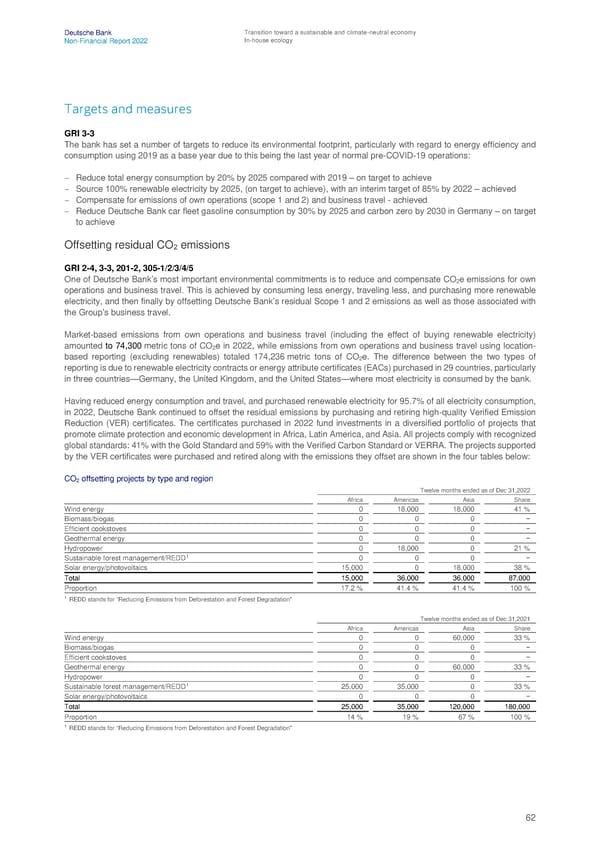Deutsche Bank Transition toward a sustainable and climate-neutral economy Non-Financial Report 2022 In-house ecology Targets and measures GRI 3-3 The bank has set a number of targets to reduce its environmental footprint, particularly with regard to energy efficiency and consumption using 2019 as a base year due to this being the last year of normal pre-COVID-19 operations: – Reduce total energy consumption by 20% by 2025 compared with 2019 – on target to achieve – Source 100% renewable electricity by 2025, (on target to achieve), with an interim target of 85% by 2022 – achieved – Compensate for emissions of own operations (scope 1 and 2) and business travel - achieved – Reduce Deutsche Bank car fleet gasoline consumption by 30% by 2025 and carbon zero by 2030 in Germany – on target to achieve Offsetting residual CO emissions 2 GRI 2-4, 3-3, 201-2, 305-1/2/3/4/5 One of Deutsche Bank’s most important environmental commitments is to reduce and compensate CO e emissions for own 2 operations and business travel. This is achieved by consuming less energy, traveling less, and purchasing more renewable electricity, and then finally by offsetting Deutsche Bank’s residual Scope 1 and 2 emissions as well as those associated with the Group’s business travel. Market-based emissions from own operations and business travel (including the effect of buying renewable electricity) amounted to 74,300 metric tons of CO e in 2022, while emissions from own operations and business travel using location- 2 based reporting (excluding renewables) totaled 174,236 metric tons of CO e. The difference between the two types of 2 reporting is due to renewable electricity contracts or energy attribute certificates (EACs) purchased in 29 countries, particularly in three countries—Germany, the United Kingdom, and the United States—where most electricity is consumed by the bank. Having reduced energy consumption and travel, and purchased renewable electricity for 95.7% of all electricity consumption, in 2022, Deutsche Bank continued to offset the residual emissions by purchasing and retiring high-quality Verified Emission Reduction (VER) certificates. The certificates purchased in 2022 fund investments in a diversified portfolio of projects that promote climate protection and economic development in Africa, Latin America, and Asia. All projects comply with recognized global standards: 41% with the Gold Standard and 59% with the Verified Carbon Standard or VERRA. The projects supported by the VER certificates were purchased and retired along with the emissions they offset are shown in the four tables below: CO offsetting projects by type and region 2 Twelve months ended as of Dec 31,2022 Africa Americas Asia Share Wind energy 0 18,000 18,000 41 % Biomass/biogas 0 0 0 − Efficient cookstoves 0 0 0 − Geothermal energy 0 0 0 − Hydropower 0 18,000 0 21 % 1 Sustainable forest management/REDD 0 0 0 − Solar energy/photovoltaics 15,000 0 18,000 38 % Total 15,000 36,000 36,000 87,000 Proportion 17.2 % 41.4 % 41.4 % 100 % 1 REDD stands for “Reducing Emissions from Deforestation and Forest Degradation” Twelve months ended as of Dec 31,2021 Africa Americas Asia Share Wind energy 0 0 60,000 33 % Biomass/biogas 0 0 0 − Efficient cookstoves 0 0 0 − Geothermal energy 0 0 60,000 33 % Hydropower 0 0 0 − 1 Sustainable forest management/REDD 25,000 35,000 0 33 % Solar energy/photovoltaics 0 0 0 − Total 25,000 35,000 120,000 180,000 Proportion 14 % 19 % 67 % 100 % 1 REDD stands for “Reducing Emissions from Deforestation and Forest Degradation” 62
 Deutsche Bank Non Financial Report Page 62 Page 64
Deutsche Bank Non Financial Report Page 62 Page 64